英语谚语中的修辞手法研究
- 格式:doc
- 大小:44.00 KB
- 文档页数:8
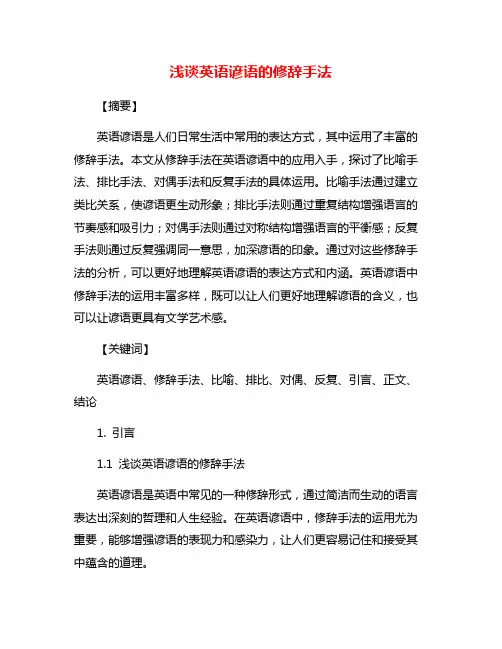
浅谈英语谚语的修辞手法【摘要】英语谚语是人们日常生活中常用的表达方式,其中运用了丰富的修辞手法。
本文从修辞手法在英语谚语中的应用入手,探讨了比喻手法、排比手法、对偶手法和反复手法的具体运用。
比喻手法通过建立类比关系,使谚语更生动形象;排比手法则通过重复结构增强语言的节奏感和吸引力;对偶手法则通过对称结构增强语言的平衡感;反复手法则通过反复强调同一意思,加深谚语的印象。
通过对这些修辞手法的分析,可以更好地理解英语谚语的表达方式和内涵。
英语谚语中修辞手法的运用丰富多样,既可以让人们更好地理解谚语的含义,也可以让谚语更具有文学艺术感。
【关键词】英语谚语、修辞手法、比喻、排比、对偶、反复、引言、正文、结论1. 引言1.1 浅谈英语谚语的修辞手法英语谚语是英语中常见的一种修辞形式,通过简洁而生动的语言表达出深刻的哲理和人生经验。
在英语谚语中,修辞手法的运用尤为重要,能够增强谚语的表现力和感染力,让人们更容易记住和接受其中蕴含的道理。
修辞手法在英语谚语中的运用可以说是无处不在。
比如常见的比喻手法,通过对不同事物之间的相似进行对比,凸显谚语的含义和意义;排比手法则是通过重复使用相同的语法结构,使谚语更加生动和有节奏感;对偶手法则是通过对称的结构和相反的词语来呈现谚语的内容,让人印象深刻;反复手法则是通过反复使用相同的词语或短语来强调谚语的重点,使人们更容易理解和记忆。
通过对英语谚语中修辞手法的分析和研究,我们可以更好地理解和欣赏这些古老的智慧之言。
在接下来的内容中,我们将深入探讨比喻手法、排比手法、对偶手法和反复手法在英语谚语中的应用,从而更好地总结英语谚语的修辞手法。
2. 正文2.1 修辞手法在英语谚语中的应用修辞手法在英语谚语中的应用是非常丰富多样的,通过巧妙运用各种修辞手法,谚语能够更生动、形象地表达出其中所包含的哲理和智慧。
修辞手法在英语谚语中的运用可以分为比喻手法、排比手法、对偶手法和反复手法等几种,每种手法都能够为谚语增添一种独特的修辞效果。
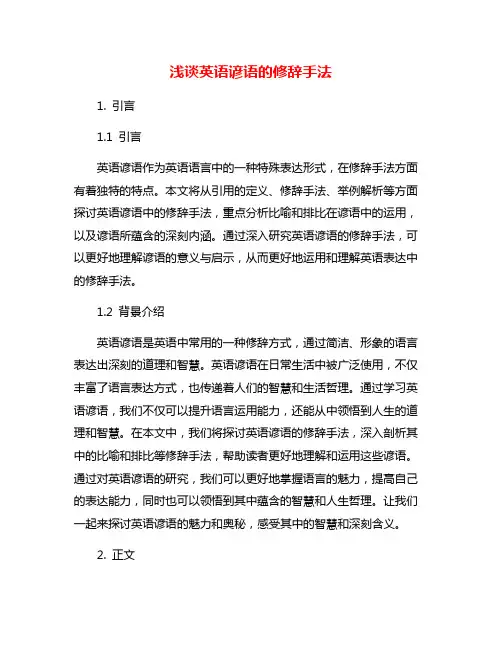
浅谈英语谚语的修辞手法1. 引言1.1 引言英语谚语作为英语语言中的一种特殊表达形式,在修辞手法方面有着独特的特点。
本文将从引用的定义、修辞手法、举例解析等方面探讨英语谚语中的修辞手法,重点分析比喻和排比在谚语中的运用,以及谚语所蕴含的深刻内涵。
通过深入研究英语谚语的修辞手法,可以更好地理解谚语的意义与启示,从而更好地运用和理解英语表达中的修辞手法。
1.2 背景介绍英语谚语是英语中常用的一种修辞方式,通过简洁、形象的语言表达出深刻的道理和智慧。
英语谚语在日常生活中被广泛使用,不仅丰富了语言表达方式,也传递着人们的智慧和生活哲理。
通过学习英语谚语,我们不仅可以提升语言运用能力,还能从中领悟到人生的道理和智慧。
在本文中,我们将探讨英语谚语的修辞手法,深入剖析其中的比喻和排比等修辞手法,帮助读者更好地理解和运用这些谚语。
通过对英语谚语的研究,我们可以更好地掌握语言的魅力,提高自己的表达能力,同时也可以领悟到其中蕴含的智慧和人生哲理。
让我们一起来探讨英语谚语的魅力和奥秘,感受其中的智慧和深刻含义。
2. 正文2.1 引用的定义"引用"是修辞手法中的一种,指的是在文章中引用他人的观点或言论来支持自己的论点。
通过引用他人的话语,可以增加文章的权威性和可信度,同时也能够更有说服力地表达自己的观点。
引用通常需要注明出处,以示尊重原作者的版权权益。
在英语谚语中,引用的形式多样,可能是直接引用他人的话语,也可能是借用某个故事或典故来阐述一个道理。
通过引用,可以使谚语更具深度和内涵,让人们更容易理解其中所包含的道理和智慧,同时也能够让谚语更加生动有趣。
在修辞学中,引用的运用需要注意引用的时机和方式,不能过多地依赖他人的观点而失去自己的独立思考,同时也要确保引用的内容和自己的论点相互协调,避免出现矛盾和不连贯的情况。
引用的灵活运用可以使文章更富有表现力和感染力,让读者更容易被文章所吸引。
2.2 修辞手法修辞手法是修辞学的重要内容之一,是指在语言表达中为了增强感染力、形象力和说服力而采用的一种技巧性手段。
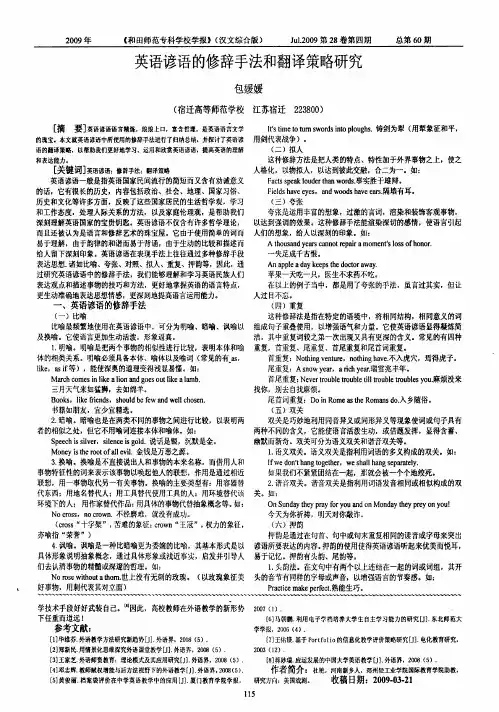
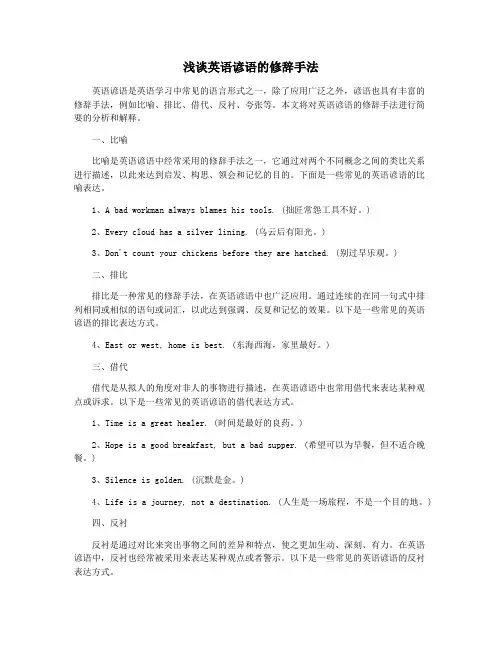
浅谈英语谚语的修辞手法英语谚语是英语学习中常见的语言形式之一,除了应用广泛之外,谚语也具有丰富的修辞手法,例如比喻、排比、借代、反衬、夸张等。
本文将对英语谚语的修辞手法进行简要的分析和解释。
一、比喻比喻是英语谚语中经常采用的修辞手法之一,它通过对两个不同概念之间的类比关系进行描述,以此来达到启发、构思、领会和记忆的目的。
下面是一些常见的英语谚语的比喻表达。
1、A bad workman always blames his tools. (拙匠常怨工具不好。
)2、Every cloud has a silver lining. (乌云后有阳光。
)3、Don't count your chickens before they are hatched. (别过早乐观。
)二、排比排比是一种常见的修辞手法,在英语谚语中也广泛应用。
通过连续的在同一句式中排列相同或相似的语句或词汇,以此达到强调、反复和记忆的效果。
以下是一些常见的英语谚语的排比表达方式。
4、East or west, home is best. (东海西海,家里最好。
)三、借代借代是从拟人的角度对非人的事物进行描述,在英语谚语中也常用借代来表达某种观点或诉求。
以下是一些常见的英语谚语的借代表达方式。
1、Time is a great healer. (时间是最好的良药。
)2、Hope is a good breakfast, but a bad supper. (希望可以为早餐,但不适合晚餐。
)3、Silence is golden. (沉默是金。
)4、Life is a journey, not a destination. (人生是一场旅程,不是一个目的地。
)四、反衬反衬是通过对比来突出事物之间的差异和特点,使之更加生动、深刻、有力。
在英语谚语中,反衬也经常被采用来表达某种观点或者警示。
以下是一些常见的英语谚语的反衬表达方式。
3、Easy come, easy go. (来得容易,去得也快。
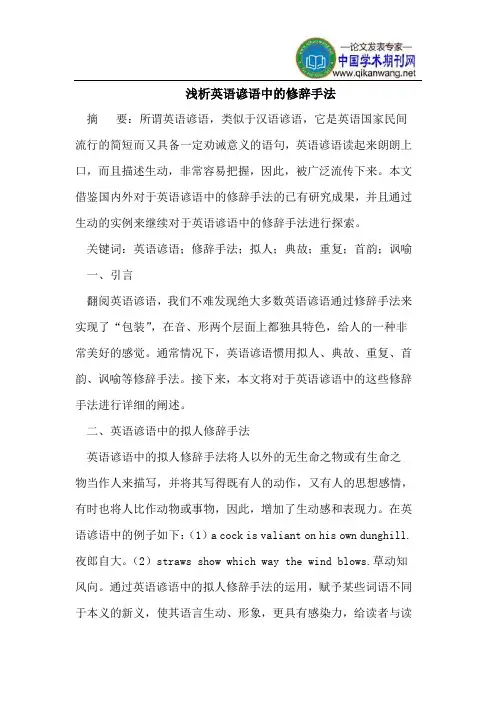
浅析英语谚语中的修辞手法摘要:所谓英语谚语,类似于汉语谚语,它是英语国家民间流行的简短而又具备一定劝诫意义的语句,英语谚语读起来朗朗上口,而且描述生动,非常容易把握,因此,被广泛流传下来。
本文借鉴国内外对于英语谚语中的修辞手法的已有研究成果,并且通过生动的实例来继续对于英语谚语中的修辞手法进行探索。
关键词:英语谚语;修辞手法;拟人;典故;重复;首韵;讽喻一、引言翻阅英语谚语,我们不难发现绝大多数英语谚语通过修辞手法来实现了“包装”,在音、形两个层面上都独具特色,给人的一种非常美好的感觉。
通常情况下,英语谚语惯用拟人、典故、重复、首韵、讽喻等修辞手法。
接下来,本文将对于英语谚语中的这些修辞手法进行详细的阐述。
二、英语谚语中的拟人修辞手法英语谚语中的拟人修辞手法将人以外的无生命之物或有生命之物当作人来描写,并将其写得既有人的动作,又有人的思想感情,有时也将人比作动物或事物,因此,增加了生动感和表现力。
在英语谚语中的例子如下:(1)a cock is valiant on his own dunghill. 夜郎自大。
(2)straws show which way the wind blows.草动知风向。
通过英语谚语中的拟人修辞手法的运用,赋予某些词语不同于本义的新义,使其语言生动、形象,更具有感染力,给读者与读者留下深刻的印象。
三、英语谚语中的典故修辞手法所谓英语谚语中的典故修辞手法就是指,许多英语谚语是来自于一个历史事件或者名言的。
在英语谚语中,许多谚语来来源于古典文学作品,更准确地说,有如下几种来源:希腊神话、圣经、伊索寓言以及文学巨匠的作品。
英语国家的许多谚语都最早记录在这些古典文学作品当中,对于英语国家的文化有着深刻的影响,能够体现出典故英语谚语的丰富内涵和语言风格,同时,应该引起注意的是,这些来自英语典故的谚语的汉语翻译既要能较完整地表达其在原典故中的寓意,又要能为广大的中国读者所接受。
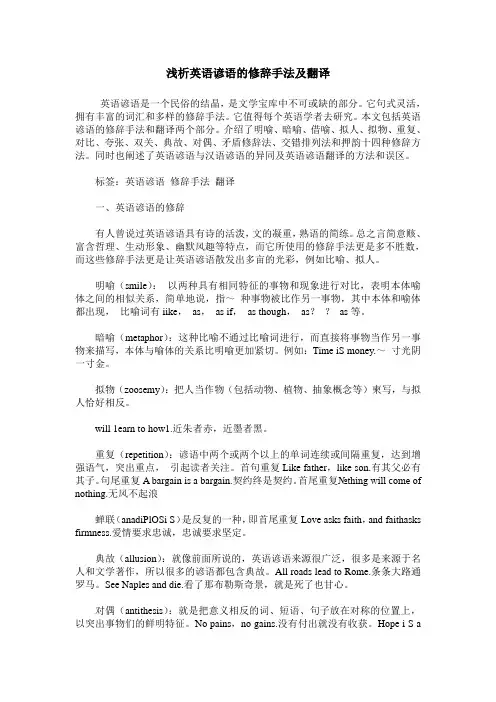
浅析英语谚语的修辞手法及翻译英语谚语是一个民俗的结晶,是文学宝库中不可或缺的部分。
它句式灵活,拥有丰富的词汇和多样的修辞手法。
它值得每个英语学者去研究。
本文包括英语谚语的修辞手法和翻译两个部分。
介绍了明喻、暗喻、借喻、拟人、拟物、重复、对比、夸张、双关、典故、对偶、矛盾修辞法、交错排列法和押韵十四种修辞方法。
同时也阐述了英语谚语与汉语谚语的异同及英语谚语翻译的方法和误区。
标签:英语谚语修辞手法翻译一、英语谚语的修辞有人曾说过英语谚语具有诗的活泼,文的凝重,熟语的简练。
总之言简意赅、富含哲理、生动形象、幽默风趣等特点,而它所使用的修辞手法更是多不胜数,而这些修辞手法更是让英语谚语散发出多亩的光彩,例如比喻、拟人。
明喻(smile):以两种具有相同特征的事物和现象进行对比,表明本体喻体之间的相似关系,简单地说,指~种事物被比作另一事物,其中本体和喻体都出现,比喻词有iike,as,as if,as though,as??as等。
暗喻(metaphor):这种比喻不通过比喻词进行,而直接将事物当作另一事物来描写,本体与喻体的关系比明喻更加紧切。
例如:Time iS money.~寸光阴一寸金。
拟物(zoosemy):把人当作物(包括动物、植物、抽象概念等)柬写,与拟人恰好相反。
will 1earn to how1.近朱者赤,近墨者黑。
重复(repetition):谚语中两个或两个以上的单词连续或间隔重复,达到增强语气,突出重点,引起读者关注。
首句重复Like father,like son.有其父必有其子。
句尾重复A bargain is a bargain.契约终是契约。
首尾重复№thing will come of nothing.无风不起浪蝉联(anadiPlOSi S)是反复的一种,即首尾重复Love asks faith,and faithasks firmness.爱情要求忠诚,忠诚要求坚定。
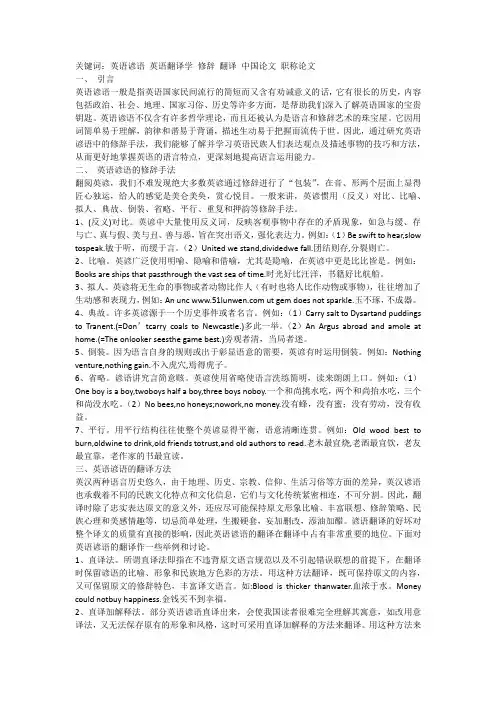
关键词:英语谚语英语翻译学修辞翻译中国论文职称论文一、引言英语谚语一般是指英语国家民间流行的简短而又含有劝诫意义的话,它有很长的历史,内容包括政治、社会、地理、国家习俗、历史等许多方面,是帮助我们深入了解英语国家的宝贵钥匙。
英语谚语不仅含有许多哲学理论,而且还被认为是语言和修辞艺术的珠宝屋。
它因用词简单易于理解,韵律和谐易于背诵,描述生动易于把握而流传于世。
因此,通过研究英语谚语中的修辞手法,我们能够了解并学习英语民族人们表达观点及描述事物的技巧和方法,从而更好地掌握英语的语言特点,更深刻地提高语言运用能力。
二、英语谚语的修辞手法翻阅英谚,我们不难发现绝大多数英谚通过修辞进行了“包装”,在音、形两个层面上显得匠心独运,给人的感觉是美仑美奂,赏心悦目。
一般来讲,英谚惯用(反义)对比、比喻、拟人、典故、倒装、省略、平行、重复和押韵等修辞手法。
1、(反义)对比。
英谚中大量使用反义词,反映客观事物中存在的矛盾现象,如急与缓、存与亡、真与假、美与丑、善与恶,旨在突出语义,强化表达力。
例如:(1)Be swift to hear,slow tospeak.敏于听,而缓于言。
(2)United we stand,dividedwe fall.团结则存,分裂则亡。
2、比喻。
英谚广泛使用明喻、隐喻和借喻,尤其是隐喻,在英谚中更是比比皆是。
例如:Books are ships that passthrough the vast sea of time.时光好比汪洋,书籍好比航船。
3、拟人。
英谚将无生命的事物或者动物比作人(有时也将人比作动物或事物),往往增加了生动感和表现力,例如:An unc ut gem does not sparkle.玉不琢,不成器。
4、典故。
许多英谚源于一个历史事件或者名言。
例如:(1)Carry salt to Dysartand puddings to Tranent.(=Don’tcarry coals to Newcastle.)多此一举。
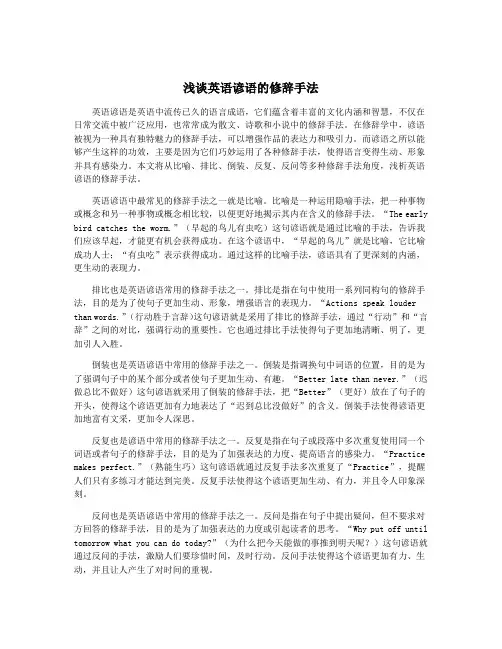
浅谈英语谚语的修辞手法英语谚语是英语中流传已久的语言成语,它们蕴含着丰富的文化内涵和智慧,不仅在日常交流中被广泛应用,也常常成为散文、诗歌和小说中的修辞手法。
在修辞学中,谚语被视为一种具有独特魅力的修辞手法,可以增强作品的表达力和吸引力。
而谚语之所以能够产生这样的功效,主要是因为它们巧妙运用了各种修辞手法,使得语言变得生动、形象并具有感染力。
本文将从比喻、排比、倒装、反复、反问等多种修辞手法角度,浅析英语谚语的修辞手法。
英语谚语中最常见的修辞手法之一就是比喻。
比喻是一种运用隐喻手法,把一种事物或概念和另一种事物或概念相比较,以便更好地揭示其内在含义的修辞手法。
“The early bird catches the worm.”(早起的鸟儿有虫吃)这句谚语就是通过比喻的手法,告诉我们应该早起,才能更有机会获得成功。
在这个谚语中,“早起的鸟儿”就是比喻,它比喻成功人士;“有虫吃”表示获得成功。
通过这样的比喻手法,谚语具有了更深刻的内涵,更生动的表现力。
排比也是英语谚语常用的修辞手法之一。
排比是指在句中使用一系列同构句的修辞手法,目的是为了使句子更加生动、形象,增强语言的表现力。
“Actions speak louder than words.”(行动胜于言辞)这句谚语就是采用了排比的修辞手法,通过“行动”和“言辞”之间的对比,强调行动的重要性。
它也通过排比手法使得句子更加地清晰、明了,更加引人入胜。
倒装也是英语谚语中常用的修辞手法之一。
倒装是指调换句中词语的位置,目的是为了强调句子中的某个部分或者使句子更加生动、有趣。
“Better late than never.”(迟做总比不做好)这句谚语就采用了倒装的修辞手法,把“Better”(更好)放在了句子的开头,使得这个谚语更加有力地表达了“迟到总比没做好”的含义。
倒装手法使得谚语更加地富有文采,更加令人深思。
反复也是谚语中常用的修辞手法之一。
反复是指在句子或段落中多次重复使用同一个词语或者句子的修辞手法,目的是为了加强表达的力度、提高语言的感染力。
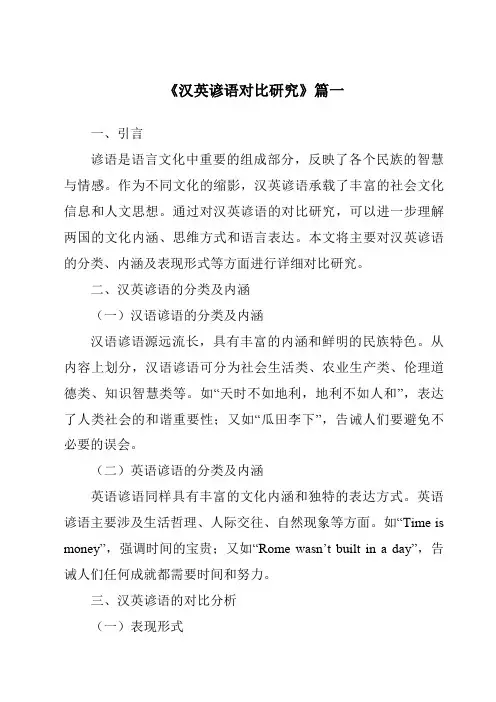
《汉英谚语对比研究》篇一一、引言谚语是语言文化中重要的组成部分,反映了各个民族的智慧与情感。
作为不同文化的缩影,汉英谚语承载了丰富的社会文化信息和人文思想。
通过对汉英谚语的对比研究,可以进一步理解两国的文化内涵、思维方式和语言表达。
本文将主要对汉英谚语的分类、内涵及表现形式等方面进行详细对比研究。
二、汉英谚语的分类及内涵(一)汉语谚语的分类及内涵汉语谚语源远流长,具有丰富的内涵和鲜明的民族特色。
从内容上划分,汉语谚语可分为社会生活类、农业生产类、伦理道德类、知识智慧类等。
如“天时不如地利,地利不如人和”,表达了人类社会的和谐重要性;又如“瓜田李下”,告诫人们要避免不必要的误会。
(二)英语谚语的分类及内涵英语谚语同样具有丰富的文化内涵和独特的表达方式。
英语谚语主要涉及生活哲理、人际交往、自然现象等方面。
如“Time is money”,强调时间的宝贵;又如“Rome wasn’t built in a day”,告诫人们任何成就都需要时间和努力。
三、汉英谚语的对比分析(一)表现形式汉英谚语在表现形式上存在一定差异。
汉语谚语多采用四字格、对仗工整的形式,如“勤能致富”、“知足常乐”等。
而英语谚语则更注重句式结构,常采用比喻、拟人等修辞手法,如“Love is like a butterfly, which goes where it pleases”(爱情就像蝴蝶,随心所欲)。
(二)内涵意义汉英谚语在内涵意义上也存在差异。
由于历史文化、社会背景的不同,汉英谚语所表达的观念和价值观也存在差异。
例如,汉语中的“谦虚使人进步”强调谦虚的重要性,而英语中的“Pride comes before a fall”则强调骄傲可能导致失败。
这些差异反映了不同文化背景下人们对谦虚与骄傲的不同理解。
(三)语言风格与文化内涵汉英谚语在语言风格和文化内涵上也有所不同。
汉语谚语往往简洁明了,寓意深刻,如“一日之计在于晨”,强调了时间的宝贵。
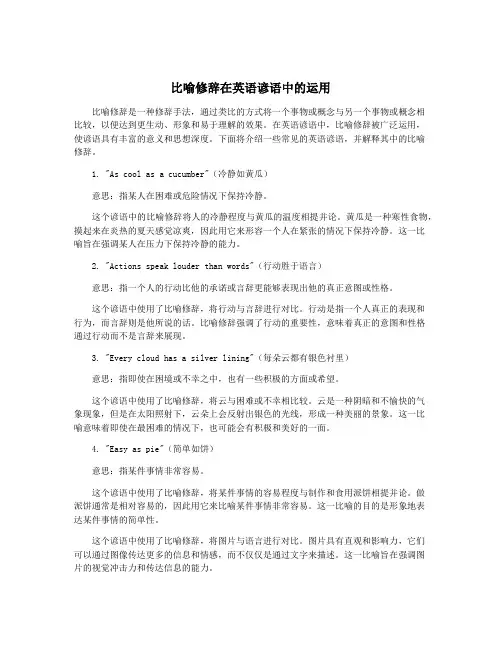
比喻修辞在英语谚语中的运用比喻修辞是一种修辞手法,通过类比的方式将一个事物或概念与另一个事物或概念相比较,以便达到更生动、形象和易于理解的效果。
在英语谚语中,比喻修辞被广泛运用,使谚语具有丰富的意义和思想深度。
下面将介绍一些常见的英语谚语,并解释其中的比喻修辞。
1. "As cool as a cucumber"(冷静如黄瓜)意思:指某人在困难或危险情况下保持冷静。
这个谚语中的比喻修辞将人的冷静程度与黄瓜的温度相提并论。
黄瓜是一种寒性食物,摸起来在炎热的夏天感觉凉爽,因此用它来形容一个人在紧张的情况下保持冷静。
这一比喻旨在强调某人在压力下保持冷静的能力。
2. "Actions speak louder than words"(行动胜于语言)意思:指一个人的行动比他的承诺或言辞更能够表现出他的真正意图或性格。
这个谚语中使用了比喻修辞,将行动与言辞进行对比。
行动是指一个人真正的表现和行为,而言辞则是他所说的话。
比喻修辞强调了行动的重要性,意味着真正的意图和性格通过行动而不是言辞来展现。
3. "Every cloud has a silver lining"(每朵云都有银色衬里)意思:指即使在困境或不幸之中,也有一些积极的方面或希望。
这个谚语中使用了比喻修辞,将云与困难或不幸相比较。
云是一种阴暗和不愉快的气象现象,但是在太阳照射下,云朵上会反射出银色的光线,形成一种美丽的景象。
这一比喻意味着即使在最困难的情况下,也可能会有积极和美好的一面。
4. "Easy as pie"(简单如饼)意思:指某件事情非常容易。
这个谚语中使用了比喻修辞,将某件事情的容易程度与制作和食用派饼相提并论。
做派饼通常是相对容易的,因此用它来比喻某件事情非常容易。
这一比喻的目的是形象地表达某件事情的简单性。
这个谚语中使用了比喻修辞,将图片与语言进行对比。
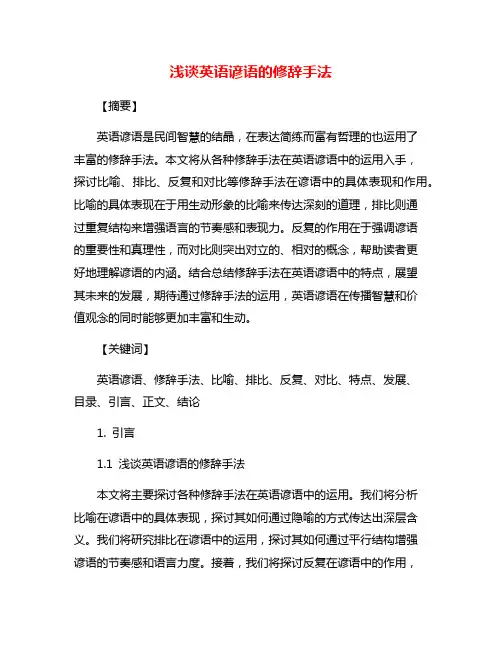
浅谈英语谚语的修辞手法【摘要】英语谚语是民间智慧的结晶,在表达简练而富有哲理的也运用了丰富的修辞手法。
本文将从各种修辞手法在英语谚语中的运用入手,探讨比喻、排比、反复和对比等修辞手法在谚语中的具体表现和作用。
比喻的具体表现在于用生动形象的比喻来传达深刻的道理,排比则通过重复结构来增强语言的节奏感和表现力。
反复的作用在于强调谚语的重要性和真理性,而对比则突出对立的、相对的概念,帮助读者更好地理解谚语的内涵。
结合总结修辞手法在英语谚语中的特点,展望其未来的发展,期待通过修辞手法的运用,英语谚语在传播智慧和价值观念的同时能够更加丰富和生动。
【关键词】英语谚语、修辞手法、比喻、排比、反复、对比、特点、发展、目录、引言、正文、结论1. 引言1.1 浅谈英语谚语的修辞手法本文将主要探讨各种修辞手法在英语谚语中的运用。
我们将分析比喻在谚语中的具体表现,探讨其如何通过隐喻的方式传达出深层含义。
我们将研究排比在谚语中的运用,探讨其如何通过平行结构增强谚语的节奏感和语言力度。
接着,我们将探讨反复在谚语中的作用,分析其如何通过反复强调某一含义或观点。
我们将探讨对比在谚语中的体现,分析其如何通过对比形成鲜明的对照效果。
通过对这些修辞手法的分析,我们可以更好地理解英语谚语的表达方式,并深入挖掘其中蕴含的丰富内涵。
同时也可以为我们今后的英语学习和交流增添更多的技巧和灵感。
将成为我们探讨的重要课题,希望能够给我们带来更多的启示和思考。
2. 正文2.1 各种修辞手法在英语谚语中的运用英语谚语是人们在日常交流中经常会用到的一种修辞表达方式,通过简洁而富有启发性的语言,传达出深刻的人生哲理和生活智慧。
在英语谚语中,各种修辞手法都得到了充分的运用,让谚语更富有表现力和吸引力。
我们可以看到英语谚语中经常运用的比喻手法。
比喻是一种通过将事物相互对应来进行说明的修辞手法,能够让抽象的概念更具体形象化。
比如谚语中的“Actions speak louder than words”就是通过比喻来强调行动比言论更有力量。
比喻修辞在英语谚语中的运用修辞是英语中一种广泛运用的修饰手法,用以增强语言的表现力。
在英语谚语中,修辞常常被运用在形象生动的比喻中,使其更具有感染力和启示性。
下面会详细介绍一些典型的比喻修辞在英语谚语中的运用。
1. "All that glitters is not gold."(闪光的不全是黄金)这句谚语通过对比宝贵的黄金和其他看起来一样华丽但并非黄金的物体,告诫人们不要只凭外表就判断事物的价值。
这句谚语在修辞上使用了比喻,将闪光的东西与黄金进行比较,强调了外表和内在价值之间的区别。
2. "Actions speak louder than words."(行动胜于言辞)这句谚语使用了比喻,将行动与言辞进行对比。
它意味着人们对一个人的行动更加重视,而不是对其口头表达的信任。
谚语中的"louder than"一词增强了这种对比的效果。
3. "A friend in need is a friend indeed."(患难见真情)这句谚语使用了修辞手法中的象征比喻,将真正的朋友比作在别人需要时愿意帮助他们的人。
这种比喻通过对朋友的品质的象征性描绘,强调了真正的友谊在困境中的价值。
4. "Every cloud has a silver lining."(乌云背后有阳光)这句谚语使用了比喻,将乌云和阳光进行对比,意味着每个困难和挑战都会有积极的一面。
它通过运用比喻,告诉人们在逆境中保持乐观和希望。
5. "The early bird catches the worm."(迟到者无虫可捉)这句谚语使用了比喻,将早起的鸟和捕食虫子进行对比。
它在修辞上使用了比喻,传达了一种价值:那些早期行动的人将有更多的机会获得成功。
6. "Don't put all your eggs in one basket."(别把鸡蛋放在一个篮子里)这句谚语通过比喻,将鸡蛋进行象征,意味着不要把所有的希望寄托在一个地方,以免失去一切。
比喻修辞在英语谚语中的运用比喻修辞是修辞手法中的一种,通过将一个事物与另一个具有共同特征或类似特征的事物相比较,来加强语言的表达效果。
在英语谚语中,比喻修辞的运用非常常见,可以让谚语更具形象生动,更富有文学性。
本文将就比喻修辞在英语谚语中的运用进行探讨。
谚语是人们在日常生活中总结出来的一些具有普遍真理的话语,而在这些谚语中,比喻修辞的运用可以使谚语更富有表现力。
比如常见的谚语“Time is money”,这句话的字面意思是时间就是金钱,在生活中也确实如此。
但是它通过将时间与金钱相比较,来强调时间的宝贵和重要,使得这个谚语更生动、更富有比喻修辞的特色。
比喻修辞可以使谚语更易于理解和记忆。
当我们用比喻的方式来表达一种概念时,往往更容易让人理解和记忆。
比如“Don't count your chickens before they hatch”(不要在鸡蛋未孵化之前数小鸡),这句谚语通过比喻的方式告诫人们不要在事情没有确定之前就过早乐观,不要过早得意忘形。
这种通过比喻修辞表达的真理,更容易让人们理解并且记牢。
比喻修辞还可以使谚语更具有鲜明的形象特点。
在英语谚语中,很多都通过比喻的方式来表达一些普世的真理,比如“All that glitters is not gold”(闪闪发光的不一定都是金子),这句谚语就是通过比喻的手法,用金子来比喻真理和财富,告诉人们并不是表面上看起来有价值的东西就是真正有价值的。
这种比喻修辞使谚语更加形象生动,并且更容易引起人们的共鸣。
比喻修辞也可以使谚语更具有文学性。
在英语谚语中,有许多都是通过比喻修辞的方式来表达一些普遍的真理和智慧。
比如“Bite off more than one can chew”(咬下了自己无法咀嚼的东西),这句谚语通过比喻的方式告诉人们不要贪得无厌,不要去做自己无法承受的事情。
比喻修辞赋予了这句谚语更多的意蕴和文学性,使得它不仅仅是一句简单的教训,更像是一种富有诗意的表达。
比喻修辞在英语谚语中的运用修辞是一种修饰语言的艺术,通过使用比喻、类比、象征、夸张等手法,能够使表达更生动有趣,给人以深刻的印象。
在英语谚语中,修辞手法得到了广泛的运用,使这些谚语更加寓意深远,引人深思。
下面将介绍一些常见的英语谚语,并分析其中的修辞手法运用。
1. All that glitters is not gold.这句谚语使用了比喻手法,通过将外表华丽的事物与黄金进行比较,暗示人们不要只看表面,要用理性的眼光看待事物。
比喻的运用使得这句谚语更加生动形象。
3. A stitch in time saves nine.这句谚语使用了类比手法,通过比较及时修补衣物和及时处理问题的重要性,告诫人们要及时采取措施解决问题,避免问题扩大化。
类比的运用使得这句谚语更加生动有趣。
4. Every cloud has a silver lining.这句谚语使用了象征手法,通过将云朵与银色的衬里进行比较,表达了即使在困难和痛苦中也能够找到希望和好处。
象征的运用使得这句谚语更加富有想象力。
5. Kill two birds with one stone.这句谚语使用了夸张手法,通过夸大手中的一块石头可以击中两只鸟的能力,表达了一次行动可以达到两个目标的效果。
夸张的运用使得这句谚语更加生动夺人。
6. When in Rome, do as the Romans do.这句谚语使用了类比手法,通过比较在不同地方应该遵守不同的习俗和规则,表达了应该遵守当地的风俗习惯。
类比的运用使得这句谚语更加形象生动。
7. Better late than never.这句谚语使用了对比手法,通过将晚一点做还好于一点不做进行对比,表达了宁愿晚一点做也比不做要好的意思。
对比的运用使得这句谚语更加鲜明有力。
比喻修辞在英语谚语中的运用比喻是修辞手法的一种,是一种通过利用形象、生动的比较来传达思想和情感的表达方式。
在英语的谚语中,比喻修辞被广泛运用,给人留下深刻印象,使谚语更加生动、有趣,同时也更加容易被人们所理解和记忆。
下面将通过一些经典的英语谚语来解释比喻修辞在谚语中的运用。
1. "A watched pot never boils."(瞪着壶盖水也不会开。
)这句谚语以“瞪着壶盖”来比喻盯着某件事情,表达的意思是过于焦急地盼望某件事情发生反而会让事情变得更加缓慢。
这里的“瞪着壶盖”就是比喻焦急地等待某件事情就像盯着壶盖期待水烧开一样。
这句谚语用“豹子”和“斑点”来比喻人的性格和本性。
意思是一个人的性格和习惯是不容易改变的,就像豹子的斑点一样固定不变。
这句谚语用“厨师”和“汤”来比喻人数过多导致事情变得混乱和不顺畅。
意思是过多的人参与到某件事情中会导致效率降低,结果变得更糟糕。
4. "A bird in the hand is worth two in the bush."(一鸟在手胜似二鸟在林。
)这句谚语用“一鸟”和“两鸟”来比喻眼前的利益和未来的可能。
意思是眼前的利益比未来的可能要更加稳妥和有价值。
5. "Don't count your chickens before they hatch."(鸡蛋未孵出之前别数鸡。
)这句谚语用“鸡蛋”和“孵出”来比喻事情的成功和结果。
意思是在事情未成功之前不要过早地乐观。
在英语谚语中,比喻修辞的运用既丰富又深刻,让人们能够更好地理解一些抽象的观念和道理。
在“Too many cooks spoil the broth.” 这句谚语中,通过比喻的方式生动地表达了过多的人参与实际上会造成事情的混乱,更加容易让人们理解和接受。
再“Don't count your chickens before they hatch.” 这句谚语警示人们不要过早地乐观,因为事情的结果往往是不确定的,通过比喻使这句谚语更加生动有趣,更加容易被人们所接受。
比喻修辞在英语谚语中的运用比喻修辞是修辞手法中的一种,通过对两种不同的事物进行相互类比来表达某种含义或者概念。
在英语谚语中,比喻修辞被广泛运用,通过对各种事物的比喻来传达智慧或者道理。
本文将探讨比喻修辞在英语谚语中的运用,并通过谚语的实例来说明这一修辞手法的精妙之处。
比喻修辞在英语谚语中的运用可以说是非常常见的。
谚语是人们在长期的生活体验中总结出来的智慧和经验的结晶,通过简洁、生动的表达方式来传递理念或者道德规范。
比喻修辞的使用使得这些谚语更具有生动性和形象性,更容易被人们理解和记忆。
"A bad workman always blames his tools."这是一个经典谚语,意思是一个不会做事的人总是会找借口责怪工具或者环境。
这个谚语通过比喻修辞将"不会做事的人"和"找借口责怪工具"进行了类比,使得这句谚语更加生动、形象。
另一个例子是"Actions speak louder than words."这句谚语通过比喻修辞将"行动"和"言语"进行了类比,表达出了行动比言语更有力量的含义。
这句谚语的形象性和生动性使得其更容易被人们理解和接受。
在英语谚语中,比喻修辞往往通过对自然界的事物进行类比来传递智慧。
"A bird in the hand is worth two in the bush."这句谚语通过对抓在手里的鸟和丛中的两只鸟进行了类比,表达了稳妥和谨慎的道理。
通过这种生动的比喻修辞,这句谚语更容易被人们理解和接受。
比喻修辞在英语谚语中的运用不仅使谚语更加生动形象,也使得谚语更具有启发性和哲理性。
通过对两种不同事物之间的类比,谚语传达出的道理更容易被人们领会和接受。
所以比喻修辞在英语谚语中的运用是至关重要的,它丰富了谚语的表达形式,使得谚语更容易为人们所理解和接受。
比喻修辞在英语谚语中的运用比喻修辞是一种修辞手法,通过使用形象生动的比喻来表达抽象的概念。
在英语谚语中,比喻修辞被广泛应用,用来传达深刻的哲理、生动的形象和强烈的感受。
下面是一些例子,说明了比喻修辞在英语谚语中的运用。
1. "A rolling stone gathers no moss."(滚石不生苔)这句谚语意味着一个经常迁移的人很难在生活中取得成就。
这个比喻通过将人比作滚动的石头,传达了一个深刻的道理。
2. "Actions speak louder than words."(行动胜于言辞)这句谚语提醒人们不仅要说出好的意图,更重要的是要采取行动来实现它们。
通过比较行动和言辞的响亮程度,这个谚语突出了行动的重要性。
3. "All that glitters is not gold."(闪光的东西未必都是金子)这句谚语告诫人们不要被外表所蒙蔽,而是要深入了解事物的本质。
通过将闪光的东西比作金子,这个比喻表达了一个普遍的真理。
4. "A bird in the hand is worth two in the bush."(手上的一只鸟胜过树上的两只鸟)这句谚语意味着稳定和确定的东西比暂时和不确定的东西更有价值。
通过将手上的一只鸟和树上的两只鸟进行比较,这个比喻表达了一个实用的观点。
6. "Don't bite off more than you can chew."(不要一口吃得太大)这句谚语告诫人们不要贪心,而是要适应自己的能力范围。
通过将吃东西比作处理任务,这个比喻传达了一种谨慎和自律的态度。
7. "A penny saved is a penny earned."(省钱就是挣钱)这句谚语表达了节俭的重要性。
通过将储蓄比作挣钱,这个比喻强调了节约的价值和对财务健康的影响。
英语谚语的修辞手法研究摘要:谚语是语言中的精华,是人类智慧的结晶。
它是熟语的一种,是流传于民间的比较简练而且言简意赅的言语形式。
多数反映了劳动人民的生活实践经验,而且一般都是经过口头传下来的。
谚语对于人民的生活起着重要的指导作用。
英语谚语是英语中非常重要的一部分,本文将从语音、语义、句法三个层次分析修辞在谚语中的使用特点,并据此揭示英语谚语在思想、智慧、语言、艺术等方面的突出成就。
英语谚语大量使用修辞格, 使之精练简洁、形象鲜明、韵律优美, 从而产生强烈的艺术感染力。
由于篇幅所限,本文只讨论了几种常见的修辞手段,还有其他对谚语有重要美学意义的修辞未曾涉及到,例如矛盾修饰、拟物、提喻、讽刺等。
因此本文只是关于修辞手段的的部分讨论,其余还有待今后进一步研究。
关键词:英语谚语; 修辞格; 艺术感染力AlliterationFeng Cuihua(1983:91) defines alliteration as “alliteration is a rhetorical device that has more to do with sound than the sense of words for effect. It is a device that repeats the same sound at frequent intervals and since the sound repeated is usually the initial consonant sound, it is also called front rhyme.”Alliteration, though, is not always used for such artistic purposes. It can also be used simply to impress something on one’s memory through sheer repetition of like initial sounds. For instance, we remember proverbs and wise sayings like “Penny wise, pound foolish” and “practi ce makes perfect” (Feng Cuihua,1983:92) because they are short and the sounds easy to remember. In present-day writing and advertisements, writers make use of this aspect alliteration quite frequently.Alliteration is used in English proverbs more often than in English poems, and it makes the proverb to be read more smoothly and easy to remember. The main rhetoric function of alliteration is to increase the rhythm of language, besides which, alliteration is sometimes used to imitate some sound in life to make the language more vivid and impressive.We can find the effects of alliteration in proverbs like:(1) Time tries truth. 时间检验真理(2) Seeing is believing. 眼见为实。
(3) Several men, several minds. 千人千品(4) Safe bind , safe find. 藏得好,容易找。
(5) Out of sight, out of mind. 眼不见,心不烦。
(6) Past cure, past care. 听之任之。
(7) Money makes the mare go. 有钱能使鬼推磨(8) Willful waste makes woeful want. 肆意挥霍,家徒四壁。
(陈明华, 2007:15-297)We could identify the rhythm and vividness of these proverbs and realize the smoothness of the short sentences easily.Consonance“Consonance, the counterpart of assonance, refers to partial or total identity ofconsonants in words or syllables whose main vowels differ. It is the close repetition of identical consonant sounds before and after different vowels. For example: slip/slop; creak/croak; black/block; shadow/meadow; pressed/past. This figure is often used in poems”. (王玉龙,张德玉,2006:248)As a matter of fact alliteration and consonance are often employed together to a speech or writing more rhythmic and appealing. Consonance used in English proverbs often gives us an impression of completeness and makes the proverbs more persuasive. It also enables us to read the proverbs in one rhythm, and displays the uniqueness of the cultures embodied in the proverbs. Here are some examples:(1) Birds of a feather flock together. 物以类聚人以群分(2) Man proposes, God disposes. 谋事在人成事在天(3) No bees, no honey.无蜂则无蜜(4) No pains, no gains.不劳则无获(5) Seeing is believing.眼见为实(6) One man,no man.孤掌难鸣(7) First thrive, and then wives先立业,后成家。
(8) East or west, home is best走遍天下路,还是家最好(9) A friend in need is a friend in deed.患难识知己(10) Good health is above wealth.健康胜于财富(11) When the cat' a away,the mice will play.山中无老虎,猴子称大王(陈明华, 2007:15-297)SimileA simile makes a comparison, but is different from an ordinary, literal comparison. When we say “Jim looks like his brother Billy”, we are making an ordinary, literal comparison, for:a) We are comparing two like elements- Jim and Billy are both human beings;b) We mean Jim is literally like his brother in appearance.But when we say “Jim and Billy are as like as two peas”, we are using a simile, for:a) We are comparing two unlike elements- human beings and peas;b) We don’t mean Jim and Billy are literally like peas, but only that they have one thing in common with peas: great similarity in appearance.“A simile, then is a figure of speech which makes a comparison between two unlike elements having at least one quality or characteristic in common.”(Feng Cuihua,1983:3) The comparison is purely imaginative, that is, the resemblance between the two unlike things in that one particular aspect exists only in our minds, in our “inward eye” and not in the nature of the things themselves. A simile is based on association and usually has four characteristics: 1) introduced by such comparative words as “like”, “as”, “as though”, “as it were”, “similar to”, “be comparable to”, “akin to”, “be something of”, etc. 2) involving two things, one of which being the primary term, the other secondary term; 3) the two things involved should be completely different; and 4) the two things should be similar in at least one characteristic. The criterion of effectiveness of similes varies from person to person.A simile is the most frequently used rhetorical device and has powerful rhetorical function. According to their functions, similes can be classified into three kinds, namely, the Descriptive, the Illustrative and the Illuminative. When used in proverbs, a simile can vividly and lifelikely describe various shapes, actions or states. We could see them in examples:(1) Fire is as hurtful as healthful.火能成灾,也能造福(2) A man without religion is like a horse without a bridle.人无信仰,犹如马无继绳(3) Use a book as a bee does flowers.读书如蜜蜂采蜜(4) Wit without learning is like a tree without fruit.没有学识的机智犹如没有果实的树(5) Beauty without virtue is like a rose without scent.美而无德犹如花无香味(6) As rust eats iron. so care eats the heart.锈能蚀铁,忧能伤人(7) Living without an aim is like sailing without a compass.比活无目的,犹如航海尤罗盘(8) A good friend is as the sun in winter.好朋友如同冬天的阳光(9)A man of words and not of deeds is like a garden full of weeds.光说不做的人,就象只长野草的花园(10) Choose an author as you choose a friend.择书如择友(11) Beauty fades like a flower.色衰似花谢(陈明华, 2007:15-297) The effect is that the reader feels like that as if he or she had been in such a scene.A simile enables the reader to find something original in what he or she has been familiar with or familiarizes the reader with what is new to him or her. For example in (8), we may experience the same feeling in our daily life, and the simile in proverbs makes it expresses convincingly as if illustrates a lively picture before us.MetaphorA metaphor, like a simile, also makes a comparison between two unlike elements, but unlike a simile, this comparison is implied rather than stated.In a simile, the words “like”, “as” are used to make the comparison, as in:1) Jim was as cunning as a fox.2) The world is like a stage.In a metaphor, however, the comparison would appear simply as:1a) Jim was a fox.2a) The world is a stage.A metaphor, then, is in a sense a condensed simile, differing from the latter only in form and artistry. “It is a figure of speech in which one thing is described in terms of another, but with no acknowledging word. It is an implied comparison between two (or more) unlike things; achieved by identifying one with the other.”(王玉龙,张德玉,2006:27) It is the application of a name of descriptive term to an object or action to which it is not strictly applicable. For example, “Money is the lens in a camera”. “the lens in a camera” in the sentence can reflect the different appearances of a person, so can money reflect the different characteristics of a person. There exists a similarity between the two.Metaphor used in English proverbs has three main uses: descriptive, illuminative and illustrative, as can be seen from the following examples:(1) A good book is the best of friends, the same today and forever.好书如相伴终生的挚友(2)A dwarf on a giant's shoulders sees the farther of the two.侏孺站在巨人的肩上,会看得史远(3) Speech is the picture of the mind.言论是心灵的写照(4) A rolling stone gathers no moss.滚石小生苔,转业小聚财(5) Old birds are not to be caught with chaff.圈套难骗练达人(6)A word spoken is an arrow let fly.出口的话如同离弦的箭(7)A teacher for a day is a father for a lifetime.一日为师.终身为父(8)Fire is a good servant but a bad master.火是忠仆,用之不慎成灾主(9)The eye is the lamp of the body 眼睛就是身上的灯(10)Books are ships that pass through the vast sea of time.时光好比汪洋,书籍好比航船(11)The world's a theatre, the earth a stage, which God and Nature do with actors fill.世界是剧院,地面是舞台,演员充其中,造化巧安排(陈明华, 2007:15-297) In these English proverbs, metaphor is used to describe the target objects. In example(1), books are described as good friends; in example(9), the eyes are said to be the lamp of the body. Inspiringly, these descriptive functions are realized in an implied way. Thus, we may get a sense of enlightenment and understand the meaning of the proverbs more impressively. In example (8), the suggestion is that fire is a good thing unless we use it properly. The illuminative function makes us examine ourselves and guide our deeds in dealing with the fire. A metaphor here expresses this effect more vividly and impressive. In example (11), the metaphor has an illustrative effect through viewing the world as theatre and the earth a stage.Hyperbole“Hyperbole is a figure of speech which deliberately exaggerates the truth. It is often used to express one’s strong feeling or violent emotions by remarkable imagination and literary extravagance, for the effect of strong impression, humor,sarcasm, irony, etc, rather than to state a fact in its right perspective.” (王玉龙,张德玉,2006:97) Hyperbole is using exaggeration, not to deceive but to emphasize a feeling or to produce a humorous effect. Hyperbole may be used for intensification of feeling or emotion; for elevation to heroic or mythical status and for humor or ridicule.Hyperbole should be both unique and reasonable, which means it should go beyond facts but can’t be divorced from reality. It is usually employed by use of numerals, adjectives, adverbs, prepositional phrases, by maximizing the meaning of words, by converting negative words into positive ones, or by being used together with other figures.When used in English proverbs, effective hyperbole, however, is more than just to emphasize something in exaggerated terms. It can be used to achieve various literary effects: to intensify emotion, to elevate or idealize persons or events to heroic or mythical status, or to poke fun at or ridicule. Moreover, its form, too, can vary from a phrase, a sentence, to a paragraph or paragraphs of description. Thus, we can find the proverbs used hyperbole more instigating. It gives us an experience of ourselves, and enhances our feeling. Now let us see some examples:(1)A single slip brings eternal regret.一失足成千占恨(2)An apple a day keeps the doctor away.苹果一人吃一个,医生不求药不吃(3)Love makes the world go round.爱情威力大,能叫地球翻(4)Content is more than a kingdom.知足胜似王国(5)Faith will move mountains.决心大,大山移(6)An unfortunate man would be drowned in a teacup.人到倒霉时.杯水会淹死(7) It happens in a moment that comes not to pass in a thousand years.天有不测风云,人有且夕祸福(8)Idleness rusts the mind.怠惰使头脑生锈(9)A cat has nine lives.猫有九条命(10)Sometimes words hurl more than swards.言语能伤人,有时胜刀剑(11)One enemy is too much. 1个敌人已太多(Yang Zengmao,1997:20-364)In these proverbs, we can see the heroic or mythical status, like in example (5) and example (4). The hyperbole in proverbs expresses our feelings in grand way and makes us very encouraging. That is also a reason why English proverbs are handed down from generation to generation, for it enables us to believe in ourselves and gives us confidence to do everything. And it is an important value of the western people, so the English proverbs are deeply rooted in the western culture. The hyperbole makes the proverbs live and prolonged.。